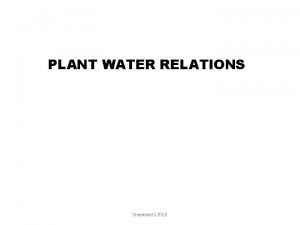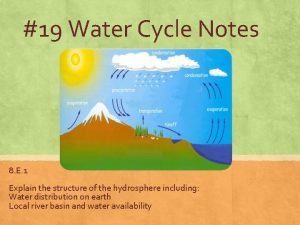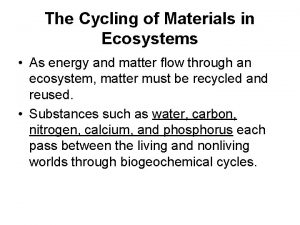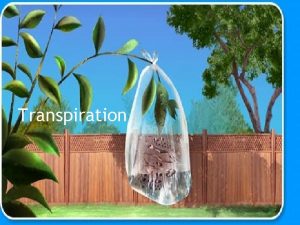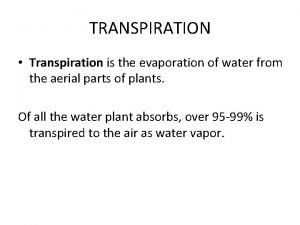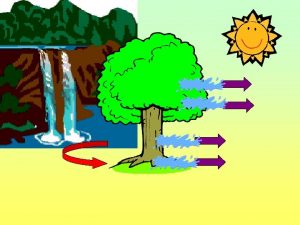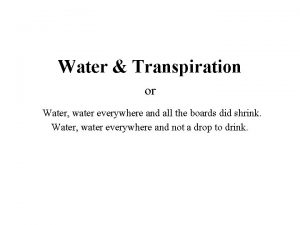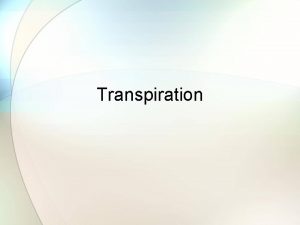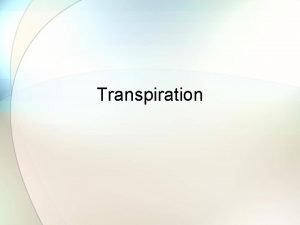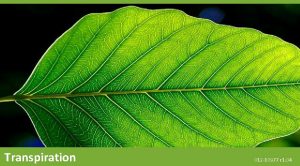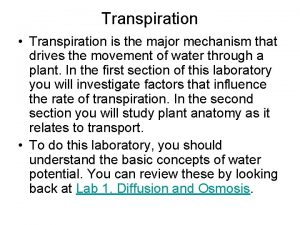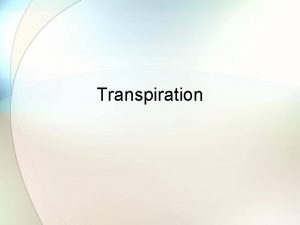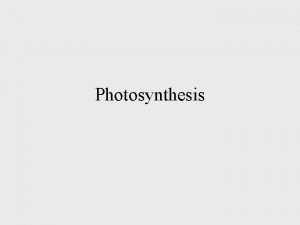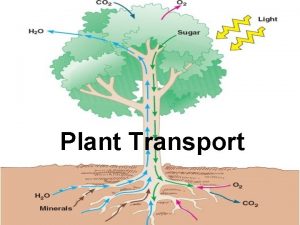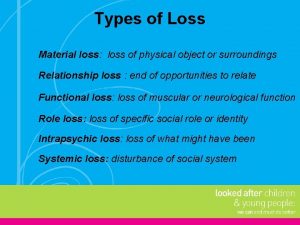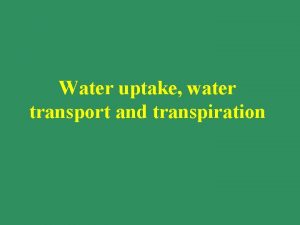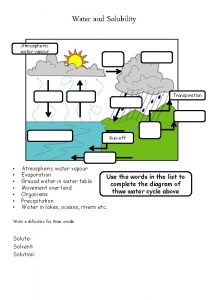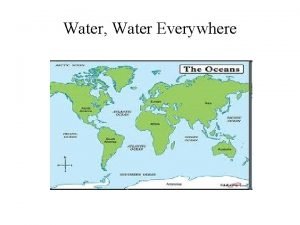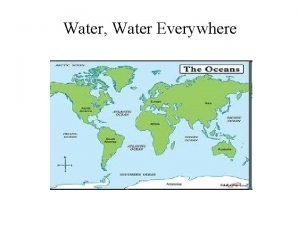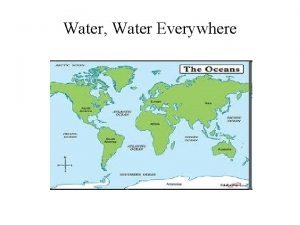Transpiration Transpiration is the loss of water from































- Slides: 31

Transpiration • Transpiration is the loss of water from a plant by evaporation • Water can only evaporate from the plant if the water potential is lower in the air surrounding the plant • Most transpiration occurs via the leaves • Most of this transpiration is via the stomata. 1

How Transpiration is Measured Water evaporates from the plant A Simple Potometer Leafy shoot cut under water Air tight seals Capillary tube Plastic tubing 1’’’’ 2’’’’ 3’’’’ 4’’’’ 5’’’’ 6’’’’ 7’’’’ 8’’’’ 9’’’’ 10’’’’ 11’’’’ 12’’’’ 13’’’’ Graduated scale Movement of meniscus is measured over time 2

How Transpiration is Measured The rate of water loss from the shoot can be measured under different environmental conditions Water is pulled up through the plant Limitations volume of water taken up in given time • measures water uptake 1’’’’ 2’’’’ 3’’’’ 4’’’’ 5’’’’ 6’’’’ 7’’’’ 8’’’’ 9’’’’ 10’’’’ 11’’’’ 12’’’’ 13’’’’ • cutting plant shoot may damage plant • plant has no roots so no resistance to water being pulled up 3

6 Environmental Factors Affecting Transpiration 1. Relative humidity: humidity air inside leaf is saturated (RH=100%). The lower the relative humidity outside the leaf the faster the rate of transpiration as the gradient is steeper 2. Air Movement: Movement increase air movement increases the rate of transpiration as it moves the saturated air from around the leaf so the gradient is steeper. 3. Temperature: Temperature increase in temperature increases the rate of transpiration as higher temperature – Provides the latent heat of vaporisation – Increases the kinetic energy so faster diffusion – Warms the air so lowers the of the air, so gradient is steeper 4

4. Atmospheric pressure: pressure decrease in atmospheric pressure increases the rate of transpiration. 5. Water supply: supply transpiration rate is lower if there is little water available as transpiration depends on the mesophyll cell walls being wet (dry cell walls have a lower ). When cells are flaccid the stomata close. 6. Light intensity : - greater light intensity increases the rate of transpiration because it causes the stomata to open, so increasing evaporation through the stomata. 5

Intrinsic Factors Affecting the Rate of Transpiration. 1. Leaf surface area 2. Thickness of epidermis and cuticle 3. Stomatal frequency 4. Stomatal size 5. Stomatal position 6

The Effect of Wind Speed on the Rate of Transpiration Stomatal transpiration rate / gcm-2 s-1 moving air In still air closing the stomata is less effective in controlling the transpiration rate still air 10 20 Stomata diameter/µm 7

Moving Air Removes the Boundary Layer of Water Vapour From the Leaf Still air Saturated air accumulates around leaf Moving air Water vapour is removed from the leaf surface cross section through a leaf Lower Boundary layer the gradient is increased, so faster rate of water evaporation via the stomata 8

Movement of Water Through the Stomata H 2 O Diffusion shells Water moves from a higher (less negative) to a lower (more negative) water potential 9

Increase in stomatal frequency increases the rate of transpiration Boundary layer stoma If the distance between the stomata is less than 10 X the pore diameter the diffusion shells overlap So increasing the number of stomata per unit area will have no further effect on transpiration 10

Wilting Subject to copyright clearance a suitable image showing plants wilting could be inserted here. e. g. one similar to that found at: If water lost by transpiration is greater than water uptake via the roots the plant cells become flaccid and the plant wilts. http: //pdc. unl. edu/sugarbeet/Rhizochtonia. Root. And. Crown. Rot/s uddenwilt. htm When the guard cells are flaccid the stomata close 11

Leaf section The upper epidermis has no stomata Subject to copyright clearance a suitable image showing a leaf section could be inserted here. e. g. one similar to that found at: http: //www. bbc. co. uk/schools/gcsebitesize/biology/greenplants asorganisms/0 photosynthesisrev 2. shtml The lower epidermis has stomata. The guard cells control the opening and closing of the stomata 12

Lower Epidermis of Tradescantia Subject to copyright clearance a suitable image showing the surface of the lower epidermis could be inserted here. e. g. one similar to that found at: www. lima. ohio-state. edu/academics/biology/images/lower. jpg 13

Surface view of leaf epidermis showing the guard cells which are flaccid and the stoma closed. Subject to copyright clearance a suitable image showing the surface of the lower epidermis could be inserted here. e. g. one similar to that found at: www. lima. ohio-state. edu/academics/biology/images 14

A single stoma and guard cells Guard cells flaccid Guard cells turgid Stoma open Stoma closed Subject to copyright clearance a suitable image showing a single stoma and guard cells could be inserted here. e. g. one similar to that found at: http: //www. plantsci. cam. ac. uk/Webb/Overview. html 15

The guard cells control the opening and closing of the stomata Guard cells flaccid Guard cells turgid Thin outer wall Thick inner wall Stoma closed Stoma open 16

Regulating Stomatal Opening: -the potassium ion pump hypothesis Guard cells flaccid K+ K+ ions have the same concentration in guard cells and epidermal cells K+ K+ K+ Light activates K+ pumps which actively transport K+ from the epidermal cells into the guard cells Stoma closed 17

Regulating Stomatal Opening: -the potassium ion pump hypothesis H 2 O K+ K+ Increased concentration of K+ in guard cells K+ K+ H 2 O K+ K+ Lowers the in the guard cells Water moves in by osmosis, down gradient 18

Guard cells turgid H 2 O K+ K+ H O 2 K+ K+ H 2 O K+ Increased concentration of K+ in guard cells H 2 O K+ K+ Lowers the in the guard cells H 2 O K+ K+ K+ Water moves in by osmosis, down gradient Stoma open 19

Xerophytes Have Special Adaptations to Reduce the Rate of Transpiration Xerophytes live in hot, dry environments Subject to copyright clearance a suitable image showing typical xerophyte features could be inserted here. e. g. one similar to that found at: These cacti have reduced leaf area as the leaves are reduced to spines http: //arboretum. ag. arizona. edu/tour/lowband/cactusgarden. html Fleshy leaves to hold water Silver surface to reflect sun 20

Adaptations to Reduce Water Loss in Xerophytes • Thick waxy cuticle to reduce evaporation • Reduced leaf area e. g. needles • Hairy leaves: leaves the hairs trap a layer of saturated air • Sunken stomata: stomata the pits above the stomata become saturated • Rolled leaves: leaves this reduces the area exposed to the air and keeps the stomata on the inside so increasing the water vapour inside the roll Increasing the water vapour around the stomata reduces the water potential gradient so slows water loss 21

Cross Section of Marram Grass Leaf is rolled with sunken stomata on the inside Hairs trap water vapour Subject to copyright clearance a suitable image showing a cross section of marram grass could be inserted here. e. g. one similar to that found at: www. microscopy-uk. org. uk/schools/images/marram. html Water evaporating via the stomata collects in the air trapped in the rolled leaf This reduces the gradient so reduces water loss from the plant 22

Adaptation to Increase Water Uptake in Xerophytes • Deep extensive root system to maximise water uptake • Accumulation of solutes in the root system to reduce the , so making the gradient from the soil to the root cells steeper • Some very shallow roots to absorb dew which condenses on the soil at night 23

Graph to show stomatal opening over 24 hours 100 stomatal opening/% Some plants close stomata during hottest time-saving water Increased light intensity causes more stomata to open An adaptation to hot dry environments Stomata close as the sun sets Dawn-stomata begin to open 0 12 2 4 6 8 10 12 24

24 h Cycle of Stomatal Opening and Closing Why is this cycle an advantage to most plants? 12. 00 09. 00 15. 00 18. 00 06. 00 21. 00 3. 00 24. 00 25

Questions 1. What is transpiration? Give three environmental factors which will increase transpiration rate. (2 marks) 2. Explain how potassium ions are moved into the guard cells in light, and how this affects the guard cells and stomata. (6 marks) 3. Give three adaptations a xerophyte may have to reduce transpiration and explain how they do this. (4 marks) 4. Plants close their stomata at night and some also close their stomata around mid day. Explain why this is advantageous to the plant (2 marks) finish Click on the marks above to check your answer 26

Answer Q 1 • Transpiration is the loss of water from a plant by evaporation • Higher temperature, increased air movement, lower humidity Back to question 27

Answer Q 2 • • • Potassium ions are pumped into the guard cells by active transport against the concentration gradient this lowers the water potential inside the guard cells water is drawn in by osmosis from the surrounding cells which have a higher water potential/down the water potential gradient • guard cells swell and become turgid • guard cells bend • causing the stomata to open any 6 from the above Back to question 28

Answer Q 3 Any three from: • Thick waxy cuticle on leaves reduces evaporation • Curled leaves reduce evaporation by trapping humid air inside the curl so reducing the water potential gradient • Reduced leaf area, e. g. spines, reduces the area from which evaporation can occur • Hairy leaves -trap a layer of humid air around the leaf, so reducing the water potential gradient • Sunken stomata – moist air trapped above stomata, so reducing the water potential gradient Back to question 29

Answer Q 4 • Stomata closed at night when there is no light for photosynthesis, so reducing water loss by evaporation/transpiration via the stomata • Closing stomata at mid day, which is the hottest part of the day, is an advantage in hot dry environments, as transpiration is reduced. Back to question 30

Can you think of any synoptic links? • • • Water potential Osmosis Active transport Respiration (energy required for active transport) Photosynthesis (light and CO 2 required for photosynthesis, CO 2 enters via stomata, water used in photosynthesis) 31
 Water and water and water water
Water and water and water water The method of unit costing is adopted by
The method of unit costing is adopted by Adhesion cohesion
Adhesion cohesion Water cycle and transpiration
Water cycle and transpiration Transpirasi yaitu penguapan air
Transpirasi yaitu penguapan air Cycling of materials
Cycling of materials Hát kết hợp bộ gõ cơ thể
Hát kết hợp bộ gõ cơ thể Lp html
Lp html Bổ thể
Bổ thể Tỉ lệ cơ thể trẻ em
Tỉ lệ cơ thể trẻ em Gấu đi như thế nào
Gấu đi như thế nào Tư thế worm breton
Tư thế worm breton Chúa yêu trần thế
Chúa yêu trần thế Môn thể thao bắt đầu bằng chữ đua
Môn thể thao bắt đầu bằng chữ đua Thế nào là hệ số cao nhất
Thế nào là hệ số cao nhất Các châu lục và đại dương trên thế giới
Các châu lục và đại dương trên thế giới Công của trọng lực
Công của trọng lực Trời xanh đây là của chúng ta thể thơ
Trời xanh đây là của chúng ta thể thơ Cách giải mật thư tọa độ
Cách giải mật thư tọa độ 101012 bằng
101012 bằng Phản ứng thế ankan
Phản ứng thế ankan Các châu lục và đại dương trên thế giới
Các châu lục và đại dương trên thế giới Thể thơ truyền thống
Thể thơ truyền thống Quá trình desamine hóa có thể tạo ra
Quá trình desamine hóa có thể tạo ra Một số thể thơ truyền thống
Một số thể thơ truyền thống Cái miệng nó xinh thế
Cái miệng nó xinh thế Vẽ hình chiếu vuông góc của vật thể sau
Vẽ hình chiếu vuông góc của vật thể sau Thế nào là sự mỏi cơ
Thế nào là sự mỏi cơ đặc điểm cơ thể của người tối cổ
đặc điểm cơ thể của người tối cổ V. c c
V. c c Vẽ hình chiếu đứng bằng cạnh của vật thể
Vẽ hình chiếu đứng bằng cạnh của vật thể Fecboak
Fecboak


